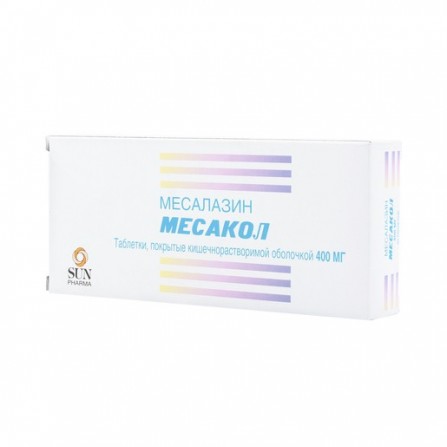Mesacol 400mg coated pills N50
Condition: New product
1000 Items
Rating:
Be the first to write a review!

More info
Active ingredients
Mesalazine
Release form
Pills
Composition
Active ingredient: mesalazine (mesalazine) Active ingredient concentration (mg): 400
Pharmacological effect
Anti-inflammatory drug with predominant localization of action in the intestine. Anti-inflammatory effect due to inhibition of the activity of neutrophilic lipoxygenase and the synthesis of prostaglandins and leukotrienes. It inhibits migration, degranulation, phagocytosis of neutrophils, as well as the secretion of immunoglobulins by lymphocytes. Mesalazine has an antimicrobial effect against Escherichia coli and some cocci (manifested in the large intestine).
Pharmacokinetics
Absorption After ingestion, mesalazine begins to be released after 110-170 minutes, after 165-225 minutes the pills completely dissolve. Due to the presence of a special shell, mesalazine is released mainly in the large intestine (60-79%). In the jejunum, 15-30% of the active substance is released, with only about 10% entering the systemic circulation. Plasma concentration is low. Distribution Mesalazine binding to plasma proteins - 43%, N-acetyl-5-aminosalicylic acid - 73-83%. The drug and its metabolite are excreted in breast milk. Metabolism In the body (intestine, liver), mesalazine is metabolized, with the formation of N-acetyl-5-aminosalicylic acid. Excretion of T1 / 2 - 0.5-2 hours depending on the dose taken, the metabolite - 5-10 hours It is excreted by the kidneys (50%) and through the intestines (40%). Pharmacokinetics in special clinical situations Cumulates in case of chronic renal failure.
Indications
UC (prevention and treatment of exacerbations); Crohn's disease (prevention and treatment of exacerbations).
Contraindications
Hypersensitivity to salicylates and other components of the drug, blood diseases, gastric ulcer and duodenal ulcer, glucose-6-phosphate dehydrogenase deficiency, hemorrhagic diathesis, severe renal / hepatic insufficiency, children age. With caution - hepatic and / or renal insufficiency.
Precautionary measures
Do not exceed the recommended dose. Use with caution in case of mild to moderate renal insufficiency, mild to moderate hepatic insufficiency.
Use during pregnancy and lactation
Currently there are no adequate clinical data on the safety of Mesacol in pregnancy. Use during pregnancy is possible only if the expected benefit of therapy for the mother outweighs the potential risk to the fetus. If you need to use the drug during lactation, breastfeeding should be stopped.
Dosage and administration
Mesalazine is prescribed to children in the form of a suspension, suppositories or microclysters.
Side effects
On the part of the digestive system: nausea, vomiting, heartburn, diarrhea, especially when using high doses of the drug (however, diarrhea is not always a consequence of the side effects of the drug, but may be a manifestation of the underlying disease); loss of appetite, abdominal pain, dry mouth, stomatitis; increased activity of liver transaminases in plasma, hepatitis, pancreatitis. On the part of the cardiovascular system: heartbeat, tachycardia, arterial hypertension or hypotension, chest pain, shortness of breath. There are separate reports on the development of pericarditis, cardiac conduction disorders. From the central nervous system: headache, tinnitus, dizziness, polyneuropathy, tremor, convulsions, insomnia, depression, hallucinations. From the genitourinary system: proteinuria, hematuria, crystalluria, oliguria , anuria, nephrotic syndrome, oligospermia. Separate cases of impotence are described. Co-side of the hematopoietic system: eosinophilia, anemia (hemolytic, omeplastic, aplastic), leukopenia, agranulocytosis, thrombocytopenia, hypoprothrombinemia. Allergic reactions: skin rash, itching, erythema, opromas, ozema, opioidosis, hypoprothrombinemia. photosensitization, lupus-like syndrome, alopecia, decreased production of tear fluid.
Overdose
Symptoms: nausea, vomiting, gastralgia, weakness, drowsiness. Treatment: gastric lavage, the appointment of a laxative, symptomatic therapy.
Interaction with other drugs
Enhances the hypoglycemic effect of sulfonylurea derivatives, ulcerogenicity of GCS, toxicity of methotrexate. It weakens the activity of furosemide, spironolactone, sulfonamides, rifampicin. Enhances the effect of anticoagulants, increases the effectiveness of uricosuric drugs for blocking the canalic secretion of the canalicular secretion (blockers of the canalic secretion of the canalous secretion of the canalous secretion of the canalous secretion of the canalic secretion of the canalic secretion (blockers of the canalous secretion of the canalic secretion of the canalic secretion of the canalous secretion of the canalous secretion, blockers, blockage of the canalous secretion of the channel, means, blockage, blockage of the canalic secretion
special instructions
It should be borne in mind that diarrhea, which may occur during treatment, is not always a consequence of the side effects of the drug, but may be a manifestation of the underlying disease. It is advisable to regularly perform a general blood test (before, during, and after treatment) and urine (control of renal excretory function). Patients who are slow acetylators have an increased risk of developing side effects. During the use of the drug, it is possible to stain the urine and tear fluid in yellow-orange color, stained vanie soft contact linz.V case skip the missed dose of the drug should be taken at any time or in conjunction with the next dose. If several doses are missed, then, without stopping treatment, you should consult a doctor. If you suspect the development of acute intolerance to Mesacol, you should cancel it. Because at low pH values do not release the active substance from the pill, Mesacol should not be administered simultaneously with drugs that reduce the pH .




